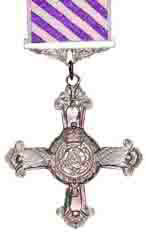Distinguished Flying Cross (DFC)
 Awarded for an act or acts of valour, courage or devotion to duty while flying in
active operations against the enemy, to personnel of the Royal Air Force and other
services.
Awarded for an act or acts of valour, courage or devotion to duty while flying in
active operations against the enemy, to personnel of the Royal Air Force and other
services.
First established
By King George V, 3 June 1918, after the formation of the RAF (Gazette issue 30723).
WW1 recipient
Cpt Eric Guy Brookes, RFC (later RAF), gazetted 3 August 1918
Brookes was a Gloucestershire-born WW1 flying ace who flew the Sopwith Camel, and was credited with 6 aerial victories.
‘While leading a patrol of six machines, escort to a bombing formation, he drove off a patrol of fifteen enemy scouts that was about to attack the bombers, shooting down one of the scouts in flames, and so enabled the bombers to complete their task. After protecting another bombing formation from a threatened attack, he escorted a third formation, to and from the lines, although by that time the number of his machines was reduced to three. On the last journey two enemy triplanes attacked one of the bombers, whose observer had been killed; engaging them, he drove one down out of control and forced the other to retire. He is a skilful and fearless officer, who has done excellent work in reconnaissance and in attacking enemy troops close to the ground’ (Gazette supplement 30827),
On 8 August 1918 Brookes died, aged 24, shot down north of Harbonnières, northern France, where he was laid to rest.
